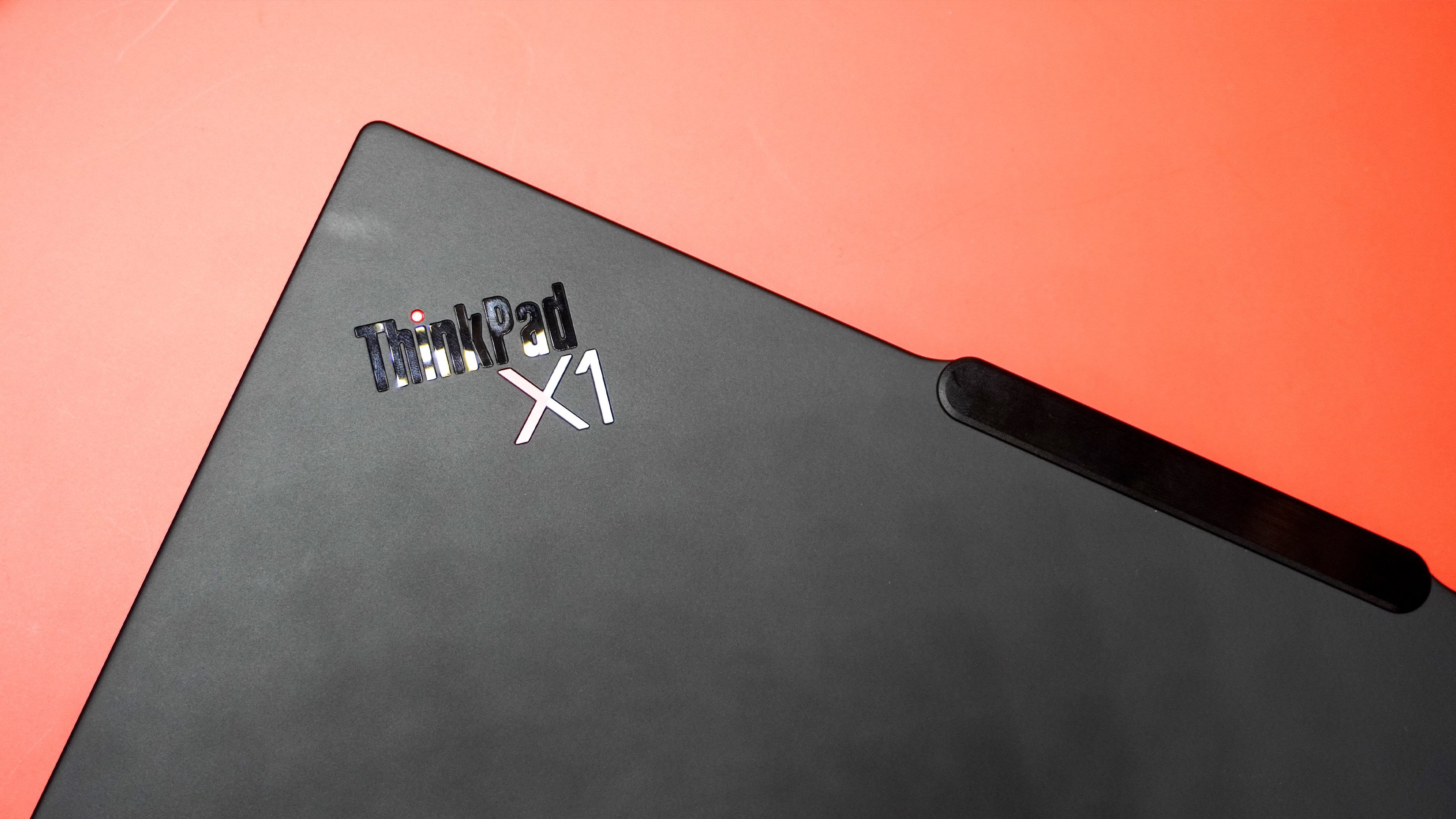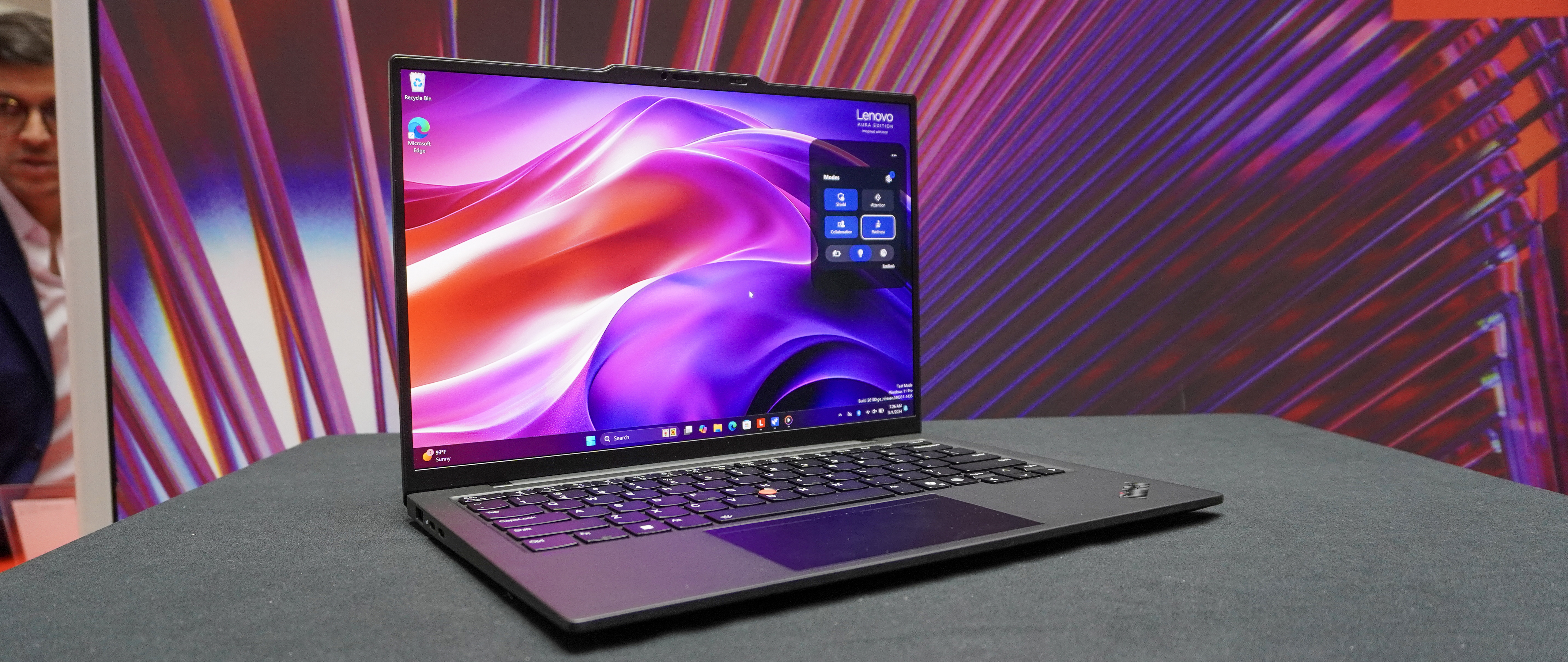Early Verdict
The Lenovo ThinkPad X1 Carbon Gen 13 Aura Edition impresses early as the defacto choice for getting work done on-the-go. Design remains unchanged (not a bad thing), ergonomics are incredible, and the new Smart Modes are a huge time saver. But Intel Lunar Lake is a bit of a let down.
Pros
- +
Same sleek design
- +
Amazing keyboard and touchpad
- +
Smart modes are actually useful
- +
Smart Share is an AirDrop killer
Cons
- -
Intel Core Ultra 200 series ain't what its cracked up to be
- -
Soft touch plastic gets dirty easily
Why you can trust Tom's Guide
The Lenovo ThinkPad X1 Carbon is a serious laptop for serious people (on paper) — well renowned as one of the best business laptops you can buy. This is because of the ergonomic marvel that is the keyboard and touchpad (or the nipple-esque TrackPoint that still has a rabid fanbase), that lightweight, utilitarian design, and the impressive battery life.
And now, at IFA 2024, we have a new generation in the Aura Edition, which packs the latest Intel Core Ultra 200 Series chipsets (otherwise known as Lunar Lake). So rather than waste your time with talking about design and usability (spoiler alert: it's the same), let's get into what is new here.
Because there's a bunch of stuff I'm really excited about here — Smart Modes makes navigating key settings for your work a cinch, and Smart Share is an absolute revelation in easily transferring content from your smartphone (even an iPhone).
However, if I'm being really honest, there's a thorn in the paw of this productivity monster in the form of that new CPU. I'll take the benchmarks I managed to get with a pinch of salt, as there could be work to do and firmware updates for Intel to apply ahead of its launch in November for €2,699 (translates literally to an insane $3,000, but I predict $1,999).
But as a first time touching a laptop sporting the brand spanking new chipset, color me a little worried that it may not be all its cracked up to be.
Lenovo ThinkPad X1 Carbon Gen 13: Specs
| CPU | Intel Core Ultra 7 (Series 2) |
| GPU | Intel Arc Xe (Integrated) |
| RAM | Up to 32GB LPDDR5x |
| Storage | Up to 2TB PCIe Gen 5 SSD |
| Display | 14-inch 2.8k OLED, 16:10 aspect ratio, 120Hz refresh rate |
| Battery | 57 WHrs |
| Ports | 2x Thunderbolt 4, 2x USB-A 3.2 Gen 1, 1x HDMI 2.1, 1x 3.5mm audio jack |
| Dimensions | 12.3 x 8.5 x 0.6 inches |
| Weight | 2.2 pounds |
Lenovo ThinkPad X1 Carbon Gen 13: What we like
More of the same is not a good thing, but you've heard it all before. So let's look past what you already know — that same sleek, lightweight design that's super durable, and the stellar ergonomics for productivity — and get to the new bits.
OLED is a feast for the eyes

It's easy for a work laptop to get long forgotten in the display department, but Lenovo makes a statement with a gorgeously sharp and fluid 2.8k OLED display.
Anything I threw at it, the 16:10 aspect ratio display presented with a flash flood of color — making me confident in not just doing the office work, but also dabbling a little in creative work like a quick Photoshop edit, or even maybe a quick AI image generation via Copilot (worth noting that Copilot+ features will launch in November for AMD and Intel laptops).
Smart modes that are actually smart

I've played this game before — a company will talk about adding some form of quick-access modes to change up your laptop, but they never really do that much. You'll normally see them called Focus Modes or something like that.
Lenovo has legitimately put time and thought into these modes, as they do make some optimal changes to suit your needs at that point. These include:
- Attention Mode: Blocks distracting websites and puts a customizable timer up so you can establish how long you want to stay focused on a task.
- Wellness Mode: A fatigue and bad posture buster, the screen temperature warms up and the ThinkPad X1 Carbon will also put up a warning if your sitting posture is bad.
- Collaboration Tools: Basically enriching video calls with AI, including low light enhancement, background blur and an easy to use presenter mode.
- Shield Mode: Working on something super sensitive? Shield mode automatically turns on the VPN and puts up privacy alerts if the laptop's webcam spots someone peeking at your screen.
A lot of these modes have existed for a while — same as those power modes between performance, balanced and eco have for years. But Lenovo has made them far easier to access with a press of that Mode button on the keyboard.
It's a top notch corner-cutting exercise to getting things done!
Your move, AirDrop

Using the M3 Pro MacBook Pro as my daily driver, I've found that AirDrop is easily one of the best implementations of wireless data transfer between devices. In Apple's own words, it just works, but I've been waiting for something similar on the Windows side.
Many companies have tried, but I think Lenovo has finally cracked the code with Smart Share, and even put the Cupertino crew to shame. How? Well all it takes is a gentle tap on the side of the screen, and before you know it, your most recent photos pop up on screen for you to save.
Using a combination of Bluetooth and Wi-Fi to transfer data, and measuring vibrations in the X1 Carbon from that knock to establish that connection, the effect is instantaneous and a massive time saver of having to upload to cloud and redownload.
This can cut a lot of corners for hard workers.
Lenovo ThinkPad X1 Carbon Gen 13: What we don't like
There's only one real glaring problem here, which I hope is just one firmware update away from being fixed. But remember the lofty promises Intel is making? ...yea
Intel Core Ultra 200 Series could be a letdown

Expectations are everything, and Intel's been busy hyping things up for Lunar Lake. But with the Intel Core Ultra 7 258V in the machine we tested, I'm really not sure what the fuss is about.
| Laptop | Geekbench 6.3 single-core | Geekbench 6.3 multicore | Geekbench AI 1.0 ONNX/CPU Full Precision |
|---|---|---|---|
| Lenovo ThinkPad X1 Carbon (Intel Core Ultra 7 258V) | 2675 | 10834 | 1654 |
| M3 MacBook Air (13-inch) | 3082 | 12087 | 3950 |
| Dell Inspiron 14 Plus (Snapdragon X Plus) | 2436 | 13281 | 2005 |
Sure, there are some performant benefits going on in the spec sheet, such as the super fast LPDDR5x RAM or the PCIe Gen 5 SSD promising fast read/write speeds. And in any other world without Snapdragon X Plus or X Elite, I'd be talking about these as respectable numbers.
But we live in a different competitive landscape of silicon now, and based on these early tests, Intel's mobile chipset just isn't cutting the mustard in multitasking, and Apple's outgoing M3 chip (given we're getting M4 MacBooks very soon) is still ahead. More interestingly, that multicore speed is actually slower than last year's Intel Core Ultra 7 in our own testing.
Lenovo ThinkPad X1 Carbon Gen 13: Early verdict

But of course, a laptop is more than the sum of its parts. I hope that the whole slow Intel thing is just a firmware issue that is fixed rapidly, but in my early time with it, I still have that space in my heart for the ThinkPad X1 Carbon.
It's the serious laptop for getting serious work done. The keyboard is an absolute joy to type on, that promised battery life of 18 hours (if true) should be good for a full day's usage, and the software tweaks Lenovo have on offer here really bring the machine into its own for productivity.

Jason brings a decade of tech and gaming journalism experience to his role as a Managing Editor of Computing at Tom's Guide. He has previously written for Laptop Mag, Tom's Hardware, Kotaku, Stuff and BBC Science Focus. In his spare time, you'll find Jason looking for good dogs to pet or thinking about eating pizza if he isn't already.

